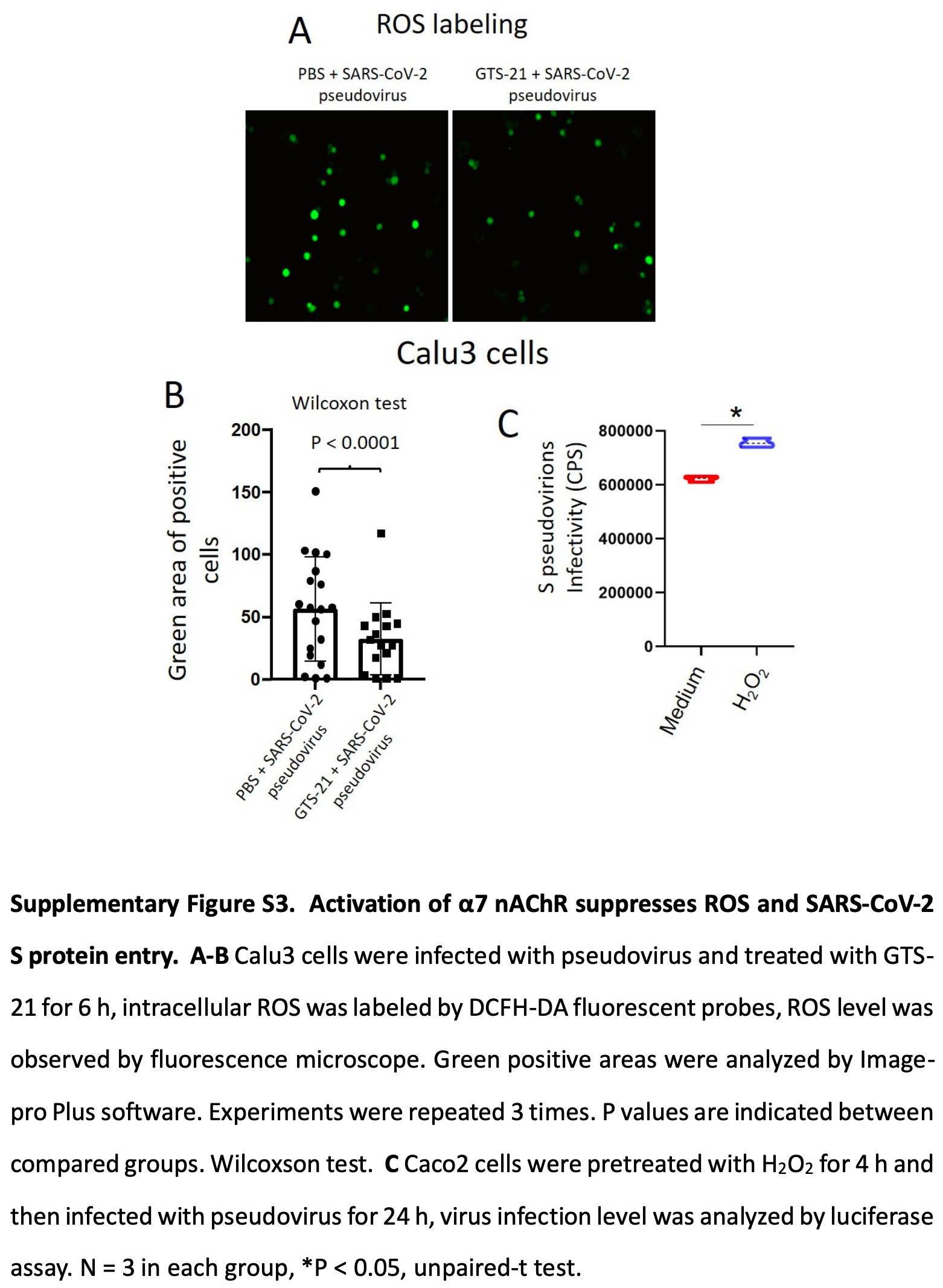Cholinergic α7 nAChR signaling suppresses SARS-CoV-2 infection and inflammation in lung epithelial cells
Jing Wen, Jing Sun, Yanhong Tang, Jincun Zhao, Xiao Su
doi:10.1093/jmcb/mjad048/7231085
The severe acute respiratory syndrome coronavirus 2 (SARS-CoV-2)-induced coronavirus disease 2019 (COVID-19) has caused more than 6 million deaths and poses a huge threat to the global economy and public health. SARS-CoV-2 enters lung epithelial cells depending on S protein binding with angiotensin converting enzyme 2 (ACE2). In-silico studies have shown that both SARS-CoV and SARS-CoV-2 S glycoproteins can interact with the extracellular domain of α7 nicotinic acetylcholine receptor (nAChR). Hydroxychloroquine, a known SARS-CoV-2 inhibitor, acts at the entry stage of SARS-CoV-2 by blocking the virus-binding sites on the two receptors, ACE2 and α7 nAChR (Navya and Hosur, 2021). Given that α7 nAChR possesses anti-inflammatory effects and could interact with the SARS-CoV-2 S protein,
References
Azabou, Bao, Bounab, Vagus Nerve Stimulation: A Potential Adjunct Therapy for COVID-19, Frontiers in medicine
Bonaz, Sinniger, Pellissier, Targeting the cholinergic anti-inflammatory pathway with vagus nerve stimulation in patients with Covid-19?, Bioelectronic medicine
Hsieh, Wang, Wu, Reactive Oxygen Species-Dependent c-Fos/Activator Protein 1 Induction Upregulates Heme Oxygenase-1 Expression by Bradykinin in Brain Astrocytes, Antioxidants & redox signaling
Kipshidze, Chekanov, Kipshidze, Transpulmonary electrotherapy for reduction of lung viral load of SARS-CoV-2 in patients with COVID-19, Medical hypotheses
Kox, Pompe, Peters, alpha7 nicotinic acetylcholine receptor agonist GTS-21 attenuates ventilator-induced tumour necrosis factor-alpha production and lung injury, Br J Anaesth
Li, Li, Wang, SARS-CoV-2 spike promotes inflammation and apoptosis through autophagy by ROS-suppressed PI3K/AKT/mTOR signaling, Biochimica et biophysica acta. Molecular basis of disease
DOI record:
{
"DOI": "10.1093/jmcb/mjad048",
"ISSN": [
"1674-2788",
"1759-4685"
],
"URL": "http://dx.doi.org/10.1093/jmcb/mjad048",
"author": [
{
"affiliation": [
{
"name": "Unit of Respiratory Infection and Immunity, Institut Pasteur of Shanghai, Chinese Academy of Sciences , Shanghai 200031 , China"
},
{
"name": "CAS Key Laboratory of Molecular Virology and Immunology, Institut Pasteur of Shanghai, Chinese Academy of Sciences , Shanghai 200031 , China"
},
{
"name": "University of Chinese Academy of Sciences , Beijing 100049 , China"
}
],
"family": "Wen",
"given": "Jing",
"sequence": "first"
},
{
"affiliation": [
{
"name": "State Key Laboratory of Respiratory Disease, National Clinical Research Centre for Respiratory Disease, Guangzhou Institute of Respiratory Health, the First Affiliated Hospital of Guangzhou Medical University , Guangzhou 510120 , China"
}
],
"family": "Sun",
"given": "Jing",
"sequence": "additional"
},
{
"affiliation": [
{
"name": "State Key Laboratory of Respiratory Disease, National Clinical Research Centre for Respiratory Disease, Guangzhou Institute of Respiratory Health, the First Affiliated Hospital of Guangzhou Medical University , Guangzhou 510120 , China"
}
],
"family": "Tang",
"given": "Yanhong",
"sequence": "additional"
},
{
"affiliation": [
{
"name": "State Key Laboratory of Respiratory Disease, National Clinical Research Centre for Respiratory Disease, Guangzhou Institute of Respiratory Health, the First Affiliated Hospital of Guangzhou Medical University , Guangzhou 510120 , China"
}
],
"family": "Zhao",
"given": "Jincun",
"sequence": "additional"
},
{
"ORCID": "http://orcid.org/0000-0002-8692-8365",
"affiliation": [
{
"name": "Unit of Respiratory Infection and Immunity, Institut Pasteur of Shanghai, Chinese Academy of Sciences , Shanghai 200031 , China"
},
{
"name": "CAS Key Laboratory of Molecular Virology and Immunology, Institut Pasteur of Shanghai, Chinese Academy of Sciences , Shanghai 200031 , China"
},
{
"name": "University of Chinese Academy of Sciences , Beijing 100049 , China"
}
],
"authenticated-orcid": false,
"family": "Su",
"given": "Xiao",
"sequence": "additional"
}
],
"container-title": "Journal of Molecular Cell Biology",
"content-domain": {
"crossmark-restriction": false,
"domain": []
},
"created": {
"date-parts": [
[
2023,
7,
26
]
],
"date-time": "2023-07-26T03:39:02Z",
"timestamp": 1690342742000
},
"deposited": {
"date-parts": [
[
2023,
7,
26
]
],
"date-time": "2023-07-26T03:39:03Z",
"timestamp": 1690342743000
},
"indexed": {
"date-parts": [
[
2023,
7,
27
]
],
"date-time": "2023-07-27T04:29:17Z",
"timestamp": 1690432157617
},
"is-referenced-by-count": 0,
"issued": {
"date-parts": [
[
2023,
7,
25
]
]
},
"language": "en",
"license": [
{
"URL": "https://creativecommons.org/licenses/by/4.0/",
"content-version": "am",
"delay-in-days": 1,
"start": {
"date-parts": [
[
2023,
7,
26
]
],
"date-time": "2023-07-26T00:00:00Z",
"timestamp": 1690329600000
}
}
],
"link": [
{
"URL": "https://academic.oup.com/jmcb/advance-article-pdf/doi/10.1093/jmcb/mjad048/50961624/mjad048.pdf",
"content-type": "application/pdf",
"content-version": "am",
"intended-application": "syndication"
},
{
"URL": "https://academic.oup.com/jmcb/advance-article-pdf/doi/10.1093/jmcb/mjad048/50961624/mjad048.pdf",
"content-type": "unspecified",
"content-version": "vor",
"intended-application": "similarity-checking"
}
],
"member": "286",
"original-title": [],
"prefix": "10.1093",
"published": {
"date-parts": [
[
2023,
7,
25
]
]
},
"published-online": {
"date-parts": [
[
2023,
7,
25
]
]
},
"publisher": "Oxford University Press (OUP)",
"reference-count": 0,
"references-count": 0,
"relation": {},
"resource": {
"primary": {
"URL": "https://academic.oup.com/jmcb/advance-article/doi/10.1093/jmcb/mjad048/7231085"
}
},
"score": 1,
"short-title": [],
"source": "Crossref",
"subject": [
"Cell Biology",
"Genetics",
"Molecular Biology",
"General Medicine"
],
"subtitle": [],
"title": "Cholinergic α7 nAChR signaling suppresses SARS-CoV-2 infection and inflammation in lung epithelial cells",
"type": "journal-article"
}
